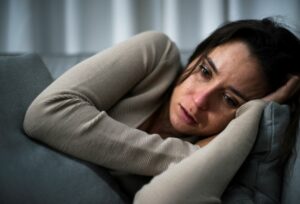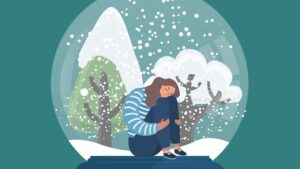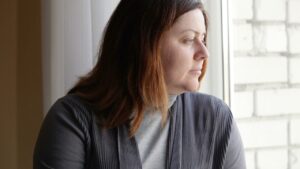“SAD,” or seasonal affective disorder, is a type of depression that people experience during the winter months. It’s not the same as regular depression. According to research, “People with SAD may be sensitive to light and withdraw from social interactions.” Learn more about this condition by reading on.
Contents
What Is Seasonal Affective Disorder?
SAD is a mood disorder that typically occurs during the fall/winter months. It’s known as “the winter blues” or simply Seasonal Affective Disorder (SAD). A lot of people might be looking forward to the changing of seasons, but some just can’t help but feel blue.
They may have changes in their mood and behavior that are related to this change of season. One study showed that about 20% of Indians experience winter-related depression each year, Although for most people it’s mild.
Signs And Symptoms 
SAD is diagnosed based on a patient’s present or past history of mood, sleep, and physical symptoms during the same time every year. There are also specific factors required for an official diagnosis: at least five depressive episodes in two consecutive years; no other psychiatric disorder accounting for the depression; not caused by substance abuse (e.g., alcohol) or medications (e.g., steroids).
Common signs and symptoms include feeling like you’ve
- Lost your motivation to do anything but lay around all-day
- Feelings of sadness
- Loneliness
- Anger
- Guilt
- Loss of interest in activities that used to be enjoyable
- Changes in appetite with weight gain
- Changes in sleep patterns
- Increased tiredness
- The feeling of being physically weak
- Sleeping more hours
- It may be helpful to take note if any or all of the following symptoms are occurring simultaneously:
- Poor concentration
- Memory loss
- Fatigue
- Low energy levels
- Feelings of social withdrawal from friends and family members
- Irritability/anger problems towards others
- Some people experience hypomania during their depressive periods which can cause them to feel excessively talkative – sometimes referred to as “word salad” – as well as feel like they’ve lost their filter and say things that, in retrospect, may not be the best to have said.
Causes of Seasonal Affective Disorder
Scientists do not know the cause of Seasonal Affective Disorder. They might think that it is related to how much daylight people are exposed to. When the days are shorter, some people’s brains might not make enough of a chemical that affects mood. Other possible causes include genetics and hormones.
Seasonal Affective Disorder affects people in the fall and winter when there is less sunlight. During these seasons, many people become sadder or more tired for no reason at all. When spring comes, they feel better.
Risk Factors For Seasonal Affective Disorder
- A family history of depression is a risk factor for developing SAD
- Women are more likely than men to develop a seasonal affective disorder
- People who live at northern latitudes
- People with bipolar I disorder
When To See A Doctor For SAD?

If you find yourself experiencing the above symptoms for more than three weeks at a time, it is likely that you are suffering from SAD. If this happens to be the case, then it would be important to see your doctor as soon as possible in order to receive treatment and relief.
Remember, everyone will experience low moods every now and again throughout their lifetime; however if these feelings begin occurring frequently (more than twice per week), there may be something deeper going on within your life or mind which needs closer examination by an expert. There’s nothing wrong with asking someone else for help.
Diagnosis For SAD

SAD is diagnosed based on a patient’s present or past history of mood, sleep, and physical symptoms during the same time every year. There are also specific factors required for an official diagnosis: at least five depressive episodes in two consecutive years; no other psychiatric disorder accounting for the depression; not caused by substance abuse (e.g., alcohol) or medications (e.g., steroids).
Treatment For Seasonal Affective Disorder
There are various types of treatment available to treat SAD, some of them are:
Light Therapy

Light therapy is a widely used treatment for winter blues. It helps in regulating sleep patterns and mood swings that are common in people suffering from SAD. Here, we will discuss how light therapy works to treat this condition:
- Light at specific times of the day reduces melatonin production which increases cortisol levels in your body. The increased cortisol level regulates your circadian rhythm thereby improving sleep quality and brightening moods.
- In case you find it difficult to get sunlight exposure during winters, use artificial lights such as fluorescent lamps or bulbs with blue-light wavelengths (5000 K) before going to bed so that their effect can be felt while you’re asleep too! These may also help reduce anxiety attacks and sleep disturbances.
- Light therapy devices are available in various forms such as light visors, boxes, and lamps which you can use at home to get relief from SAD symptoms. It is advisable to take professional help while choosing the right device for yourself so that it suits your needs perfectly.
Psychotherapy
- Psychotherapy is helpful in treating SAD symptoms by identifying the root cause of this condition. It also helps you to come out of your comfort zone and overcome social fears which are often associated with seasonal depression.
- Psychodynamic methods, Cognitive Behavioral Therapy (CBT), Interpersonal Psychotherapy (IPT), or Mindfulness-based therapies can help you get relief from depressive episodes during winters.
- You may avail of psychotherapeutic services offered by a psychiatrist who will guide you through different coping strategies that work best for curbing depression naturally without causing any side effects on your body.
You may also opt for alternative remedies like meditation, yoga, or exercising daily during this season to stay fit and enhance moods naturally. Also, maintain a healthy diet with lots of fresh fruits and vegetables to improve vitamin D concentrations in your body since deficiency of this nutrient causes poor sleep patterns due to its role in regulating circadian rhythm too.
People with depression can sometimes have good days when they eat healthy food. Healthy food is high in protein, carbohydrates, and fats. Exercise can help people feel better when they do it in moderation.
Conclusion
Seasonal Affective Disorder is not just a winter problem. It can also affect people who are living in warmer climates or even those with seasonal allergies. If you think that this may be affecting your mood, get help! We hope the information we’ve provided has been helpful to you and if it wasn’t, please contact us for more resources on managing mental health during these times of the year. You deserve happiness all year long.
For more information, please contact MantraCare. Depression is a mental illness characterized by persistent feelings of sadness, hopelessness, and loss of interest in daily activities. If you have any queries regarding Online Depression Counseling experienced therapists at MantraCare can help: Book a trial Depression Therapy session




